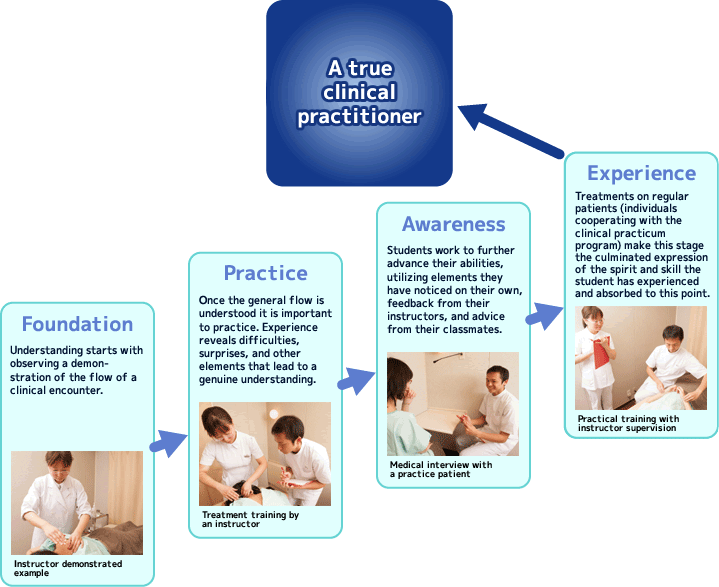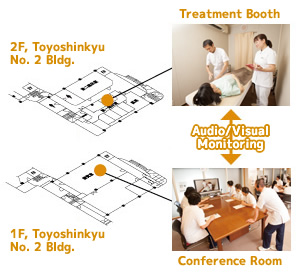Substantial Instruction in Practical Technique, Including Participatory Clinical Practicums
Learning the spirit and skill of a clinical practitioner through repeated practice
Toyoshinkyu College of Oriental Medicine implements an original participatory clinical practicum in order to foster knowledge and skills that can be utilized in actual clinical settings. It is our objective for students to gain hands-on understanding and experience with the knowledge, attitude, language, and series of medical treatment protocols (medical interviews, physical examinations, treatment, etc.) that define a clinical practitioner. Moreover, we aim to make these qualities persistent habits for our students.
Toyoshinkyu utilizes a conference room that is outfitted with audio and visual monitors of clinical practicum treatment rooms. This system allows students to observe in real time the treatments provided by their classmates in the treatment rooms, and then make observations and engage in discussions about the treatment methods and content. The results of these discussions are provided to the treatment rooms as immediate feedback, where it can be reflected in future clinical encounters.

The participatory clinical practicum: classmates share the experience!

A conference room equipped with AV systems allows for real time observation of the sights and sounds of treatments provided in Toyoshinkyu clinical facility treatment rooms.
The participatory clinical practicum allows for both student practitioners and their classmates to join together in integrating their learned skills and knowledge in a course that further expands the learning process.
The practicum allows for student practitioners to have their treatments observed and for involvement in discussions about medical practices during treatments.
In this course, it is our objective to have students gain hands-on understanding and experience with the attitude, language, and series of medical treatment protocols (medical interviews, physical examinations, diagnostics, treatment, etc.) that define a clinical practitioner. Moreover, we aim to make these qualities persistent habits for our students.
Participatory clinical practicum: course structure
1. Students in the participatory clinical practicum form groups of a few people for each patient. One student from each group becomes the student practitioner and, under the supervision of the instructor in charge, this student practitioner performs a complete session from medical interview to treatment with a regular patient who has agreed to cooperate with student practical training.
2. Other group members are able to observe in real time the medical treatments provided by their classmate in the treatment room. These students then make observations and engage in discussions about the treatment method and content. Viewing the experiences of a student practitioner allows for group members to feel as if they are actually in the treatment rooms, which in turn becomes an experience they can apply to their own clinical experiences.
3. Post-treatment discussions with other group members on such topics as the case and the choice of treatment contribute to the student practitioner gaining new insights.
4. Rotating group members into the student practitioner role for subsequent practicum sessions allows for the development of truly sensitive medical practitioners.
Merits of the participatory clinical practicum:
• You can realize, at an early stage in your education, what kind of acupuncture and moxibustion practitioner you want to become by watching someone other than yourself providing treatments in real time.
• You become aware of the reasons to study in your classes. Awareness of these reasons allows you to focus on your studies.
• You can experience actually performing an entire clinical sequence, from the initial approach to treatment.
• You gain an opportunity to think about patients’ feelings and can experience the tension of an actual treatment session by treating patients who have agreed to be a part of the practicum.
• You can engage in discussions with classmates about a specific case you have witnessed firsthand.
• You can ask your classmates for their opinions on the treatment you provide.
• You can have an instructor observe you one-on-one from the initial approach to treatment.
• You can experience even more productive approaches, treatments, and discussions because the Toyoshinkyu Principal takes the initiative in providing feedback and with conversations.
• You can apply all of this in clinical practice after graduation.
For more information on practical training classes, see “About Practical Training Classes.”
For more information on devotion to skill, see “Improve Your Skills by Choosing to Participate.”


